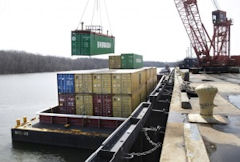 The Richmond region has the potential to become a leading center of shipping and distribution, and logistics could become one of the key drivers of the regional economy, concludes a report prepared by the Logistics Task Force of Richmond’s Future, “The Future of Logistics in the Richmond Region: Getting to the Tipping Point.”
The Richmond region has the potential to become a leading center of shipping and distribution, and logistics could become one of the key drivers of the regional economy, concludes a report prepared by the Logistics Task Force of Richmond’s Future, “The Future of Logistics in the Richmond Region: Getting to the Tipping Point.”
Over and above its mid-Atlantic location, access to four Interstate highways and proximity to the Ports of Virginia in Hampton Roads, the Richmond-Petersburg region has three pillars to build on:
- Fort Lee. The U.S. Army is building out Fort Lee at a cost of $2 billion to become its logistical training center. The Army Logistics University (ALU), it is estimated, will train 35% of the Army’s personnel at some point during their careers. The potential exists to tap this expertise for the benefit of logistics-based companies in the Richmond-Petersburg region.
- The Virginia Logistics Research Center. A logistics research center, backed by four Virginia universities, would use academic research to promote the rapid commercialization of logistical technologies. The research collaborative, which is in the advanced business-plan phase, would be supported financially by the private sector.
- The Port of Richmond. Now that the Port of Richmond has been incorporated into the Virginia Port Authority and regular barge traffic has been established with Hampton Roads, the riverine facility has the makings of an Inland Port comparable to the one in Front Royal. With improved connections to major rail lines, such a facility could function as the nucleus for warehousing and manufacturing development.
The Greater Richmond Partnership identified logistics years ago as one of the Richmond region’s strongest industry clusters. World-class freight carriers are headquartered here, such as Estes Express Lines and UPS Freight (formerly Overnite Transportation), as are Fortune 500 companies that are built upon logistical competencies such as Universal Leaf, a global tobacco distributor, and Owens & Minor, a national distributor of hospital supplies. Presumably, these companies would benefit from access to a logistics resources such as the Army Logistics University and the logistics research center.
There is a lot of work to do, however, before Richmond develops a world-class logistics cluster. It is not clear from the Task Force paper how to make the Army Logistics University a magnet for attracting talent and corporate capital to the region — the graduates, after all, will be reassigned to Army posts around the world. However, Virginia universities may be able to collaborate with the Army to build stronger logistical-related training programs accessible to corporate clients.
The research center is still an aspiration, not a reality. And the inland port idea, while interesting, offers few obvious synergies with Fort Lee or the research center. Be that as it may, the authors are asking the right questions and groping for productive answers. The ideas are all worth pursuing. While it make not yet be clear on how all the pieces fit together, the prospects of building a globally competitive logistics cluster are inherently more realistic and achievable than chasing will o’ the wisps such as biotechnology or semiconductors.
— JAB


